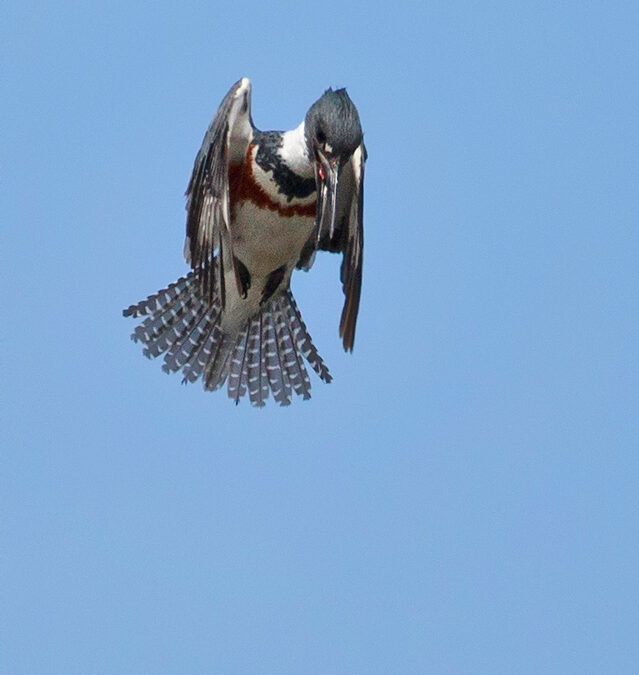
by Scott Martin Photography | Apr 23, 2013 | Birds, Blog, Shore Birds & Waterfowl
The Belted Kingfisher is one of approximately one hundred species of Kingfishers world-wide however it the only Kingfisher found commonly throughout the entire North American continent. It is an easily recognizable bird owing to its relatively large head and bill along with a shaggy looking crest. One of few birds that nests underground where it lives in a burrow dug out of the side of a river bank. Interestingly, it always burrows in an uphill direction such that in the event of flooding an air pocket is trapped at the top of the burrow allowing it to survive until the flood waters recede. Kingfisher tunnels have been recorded up to eight feet in length. Its diet consists of many things including crayfish, amphibians, small mammals, birds and even berries however it is primarily a fish specialist. The Belted Kingfisher perches above streams or hovers in flight above the water looking for fish to dive for.
For bird photographers, the Belted Kingfisher often appears on the top of what is euphemistically known as the nemesis list, or list of birds that has generated the most difficulty, frustration and angst to photograph. Although Belted Kingfishers are very common along rivers and streams in North America, they tend to be very skittish and don’t allow people close access, thus making them difficult to photograph. My good friend and fellow bird photographer Arni Stinnissen and I have enjoyed a friendly rivalry over the past few years to capture some quality images of Kingfishers, and most certainly Arni’s results have been far superior to mine as you can see in his Kingfisher Gallery. Last month, while vacationing in Florida, Deb & I had the opportunity to watch a Belted Kingfisher fish for about thirty seconds approximately one hundred feet from where we were standing on the shore of Lake Kissimmee. Fortunately I was able to get a few shots of the Belted Kingfisher diving. Although the distance from the bird precluded the quality of images one would like, they do capture the diving behaviour of the Kingfisher which is something rather unusual and I trust you will enjoy seeing.
The Kingfisher was hunting along the shoreline of the lake and as there were no perches in the area, she would hover about thirty feet above the water looking for fish.
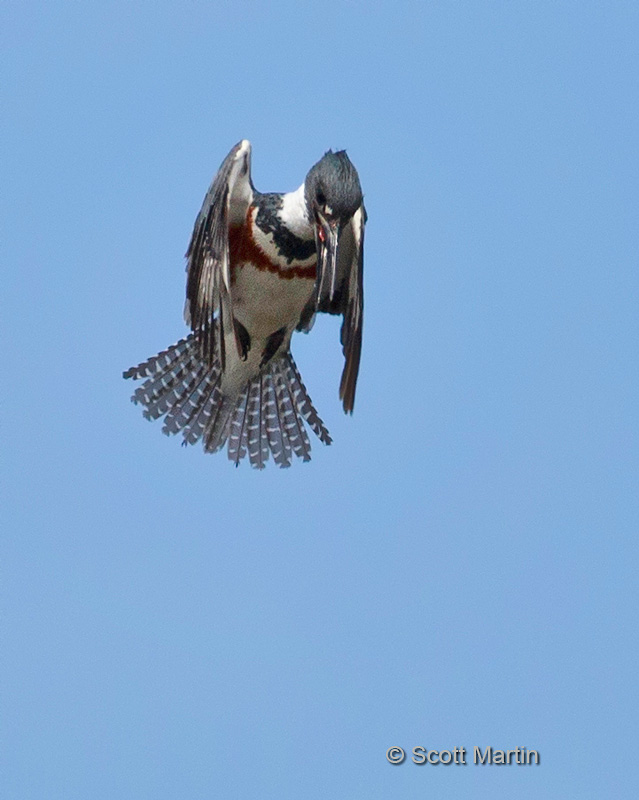
The female Belted Kingfisher is slightly larger than the male and is also one of the few species of bird where the female is more colourful than the male. The female is easily differentiated from the male by the rufus stripe across the chest below the slate blue belt that is found in both sexes.
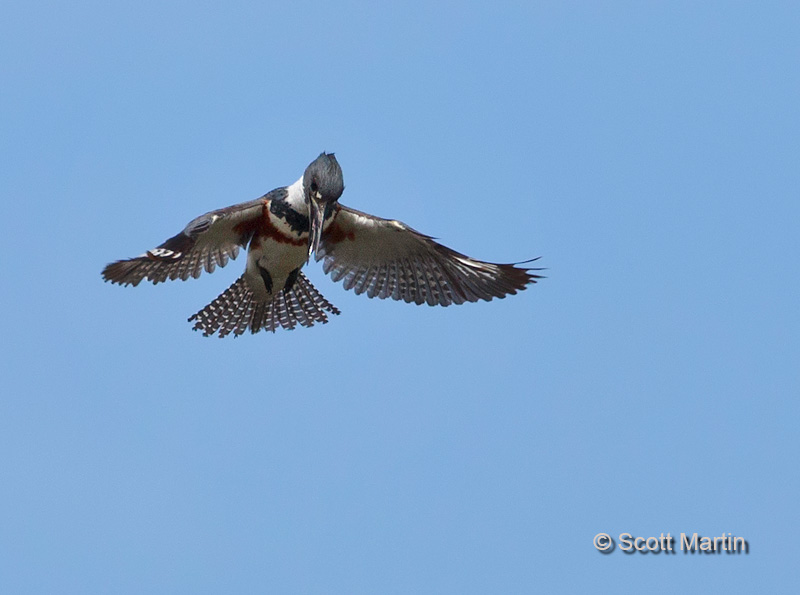
Once a fish is spotted the Kingfisher dives very quickly striking the water at a high rate of speed propelling it well below the surface.
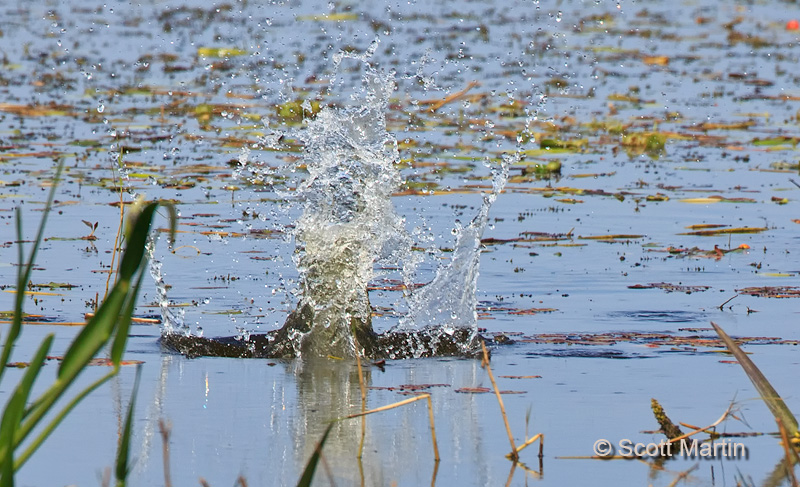
Note the clean lines of the entry zone, which will help make the next few slides make more sense as they record the Kingfisher launching itself out of the water at the end of its dive. Although I’ve seen Kingfishers dive many times before I had no idea how they launched themselves out of the water so the following images proved very educational. The next slide shows the appearance of the tail and wingtips as the Kingfisher prepares to use a strong wing beat to propel her body straight up out of the water. You can tell this is an exit shot by the waves around the impact zone and the seaweed in the air above the bird caused by the prior impact.

The energy expended to launch the bird vertically from the water must quickly exhaust the bird, so I doubt they can make many dives without a rest.
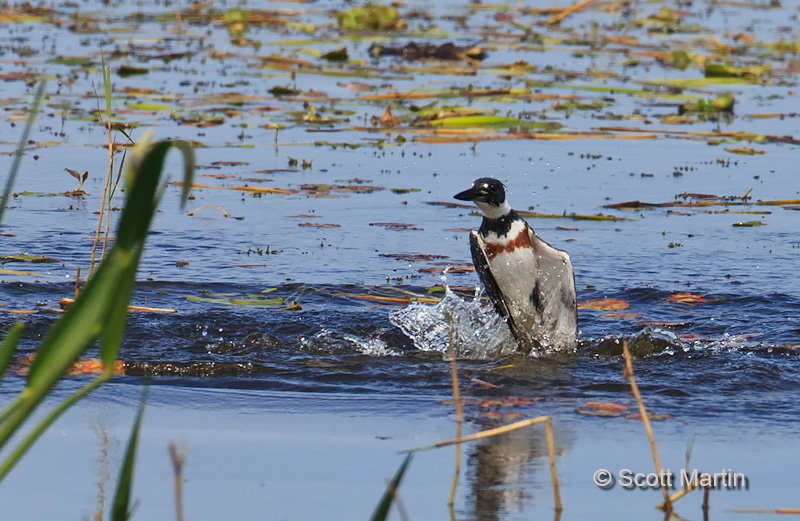
The vertical distance required must be high enough for the bird to take flight.
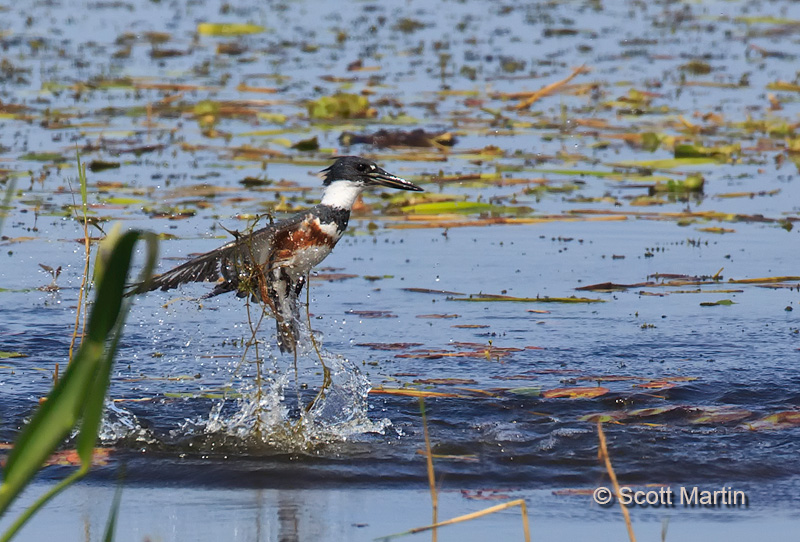
And off she goes, in this instance without any food.
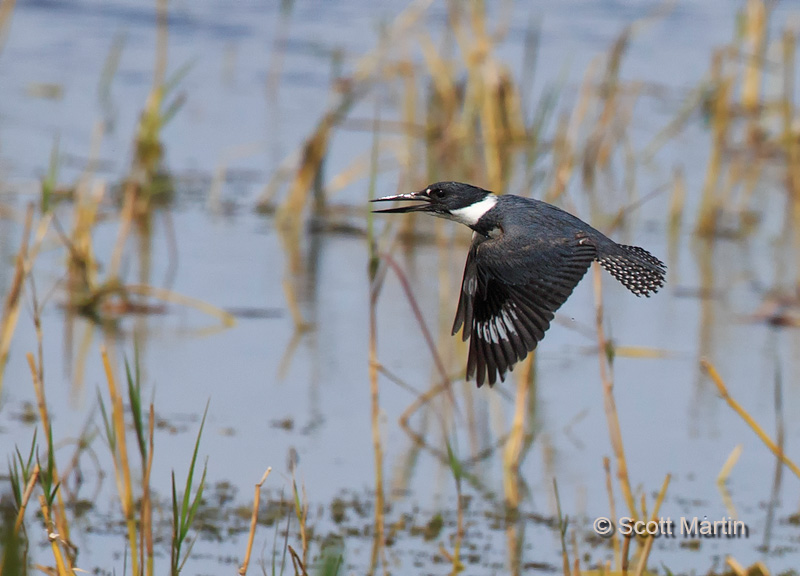
.
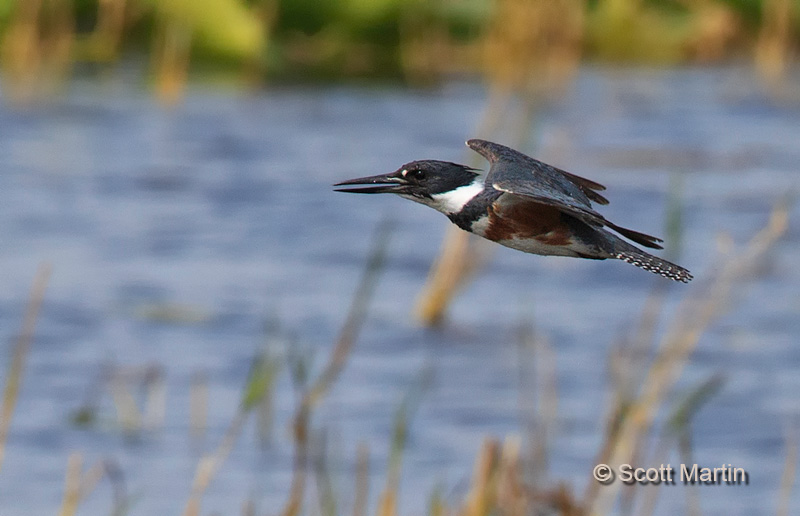
.
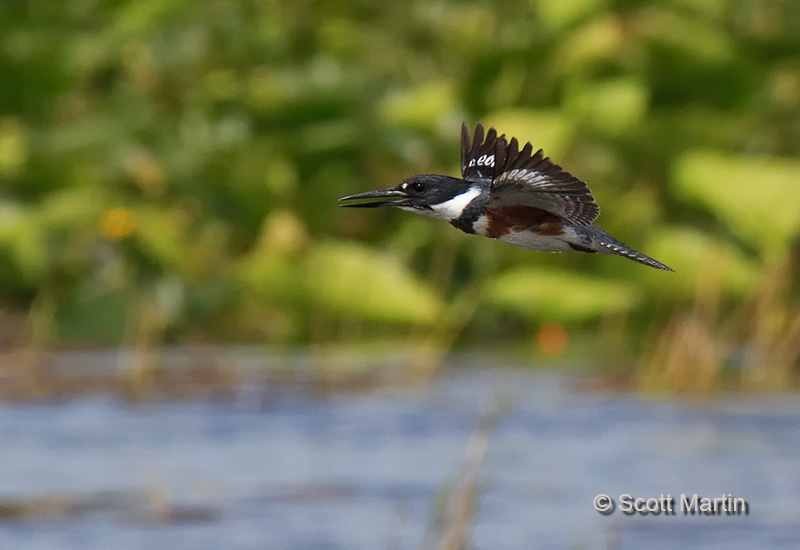
.

It was a blessing to be standing in the right place at the right time to record this Belted Kingfisher diving and as a result learn a little about how they ‘eject’ themselves from the water after a dive. It was also a pleasure to ‘kind of’ cross a longstanding bird off the nemesis list, not completely though, as I still need to get some print worthy images of this intriguing bird.
The above sequence was taken using a Canon 5D MkIII with a 500 mm f/4 lens, not a set-up typically used for birds in flight, however the 5D autofocus seemed to track the bird well.
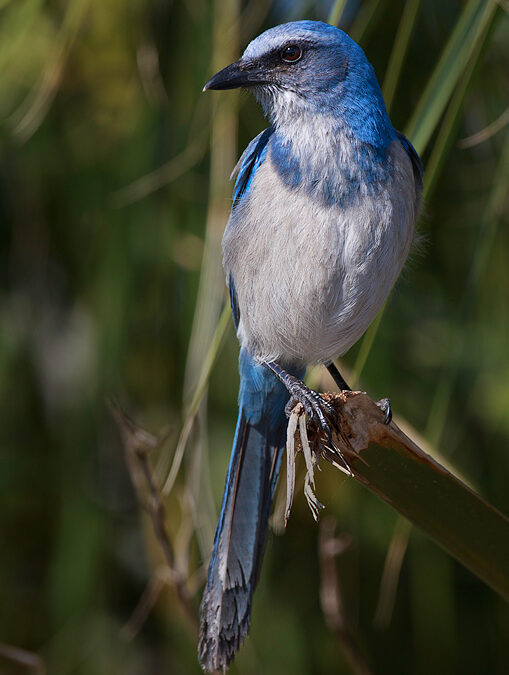
by Scott Martin Photography | Apr 13, 2013 | Birds, Blog, Educational, Song Birds
The Florida Scrub Jay is Florida’s only endemic bird and one of only fifteen bird species endemic to the United States. It is believed that there are approximately 8,000 Florida Scrub Jays alive and their numbers are decreasing at a rate of approximately 10% every ten years. As a result of their rarity and decreasing numbers they have been listed as Vulnerable, which means that unless conservation action to restore their dwindling habitat is taken they will become threatened.
As the Florida Scrub Jay is only found in Central Florida, the bird tends to be a celebrity among birders who travel long distances to see one. In fact, Deb & I met a couple from Sweden who had travelled to Florida last month just to see a Florida Scrub Jay. It was our pleasure to take them to an area where Scrub Jay’s were nesting and they were able to check another species off their life list. An interesting characteristic of the Scrub Jay is their inquisitive, social nature that renders them very tame. They readily land on your hand, shoulder or camera lens waiting to be fed a peanut. This comes as a complete surprise when you first encounter Scrub Jays as although they may be rare and difficult to find, when you do, they are instantly your best friends.
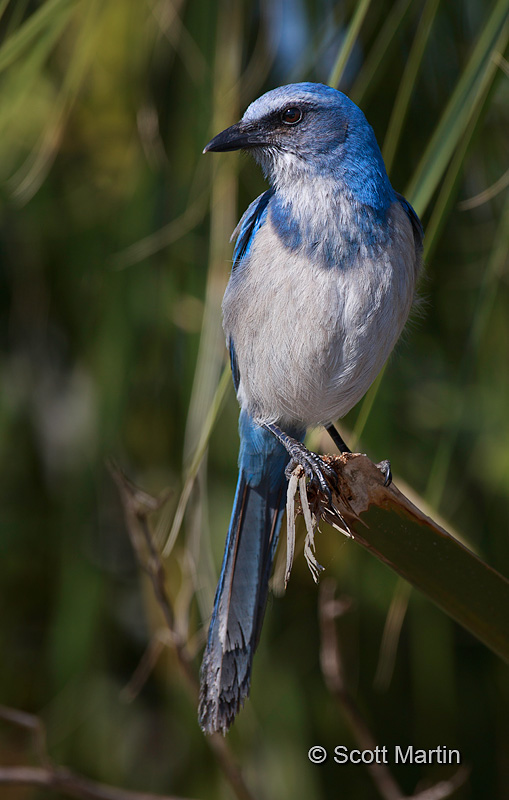
They do look similar to our Blue Jays and are about the same size as well.
Due to their friendliness and unique stature Florida Scrub Jays are among the most studied of all the birds. Consequently most seem to banded, much like we see with our Gray Jays in Algonquin Park. Scrub Jays normally have three or four bands, a silver metal band with an ID # from the US Fish & Wildlife Service, plus two or three coloured plastic bands which indicate when and where the bird was banded. The banding of birds allows researchers to monitor the movements of birds within their range as well as record other data. The next image shows a banded bird.
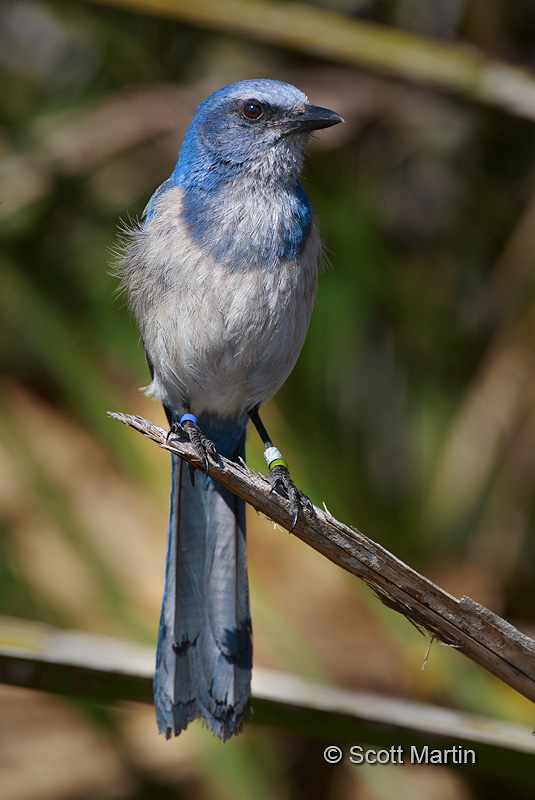
The next profile shot illustrates their lack of wing colour and detail as typical with our Blue Jays.
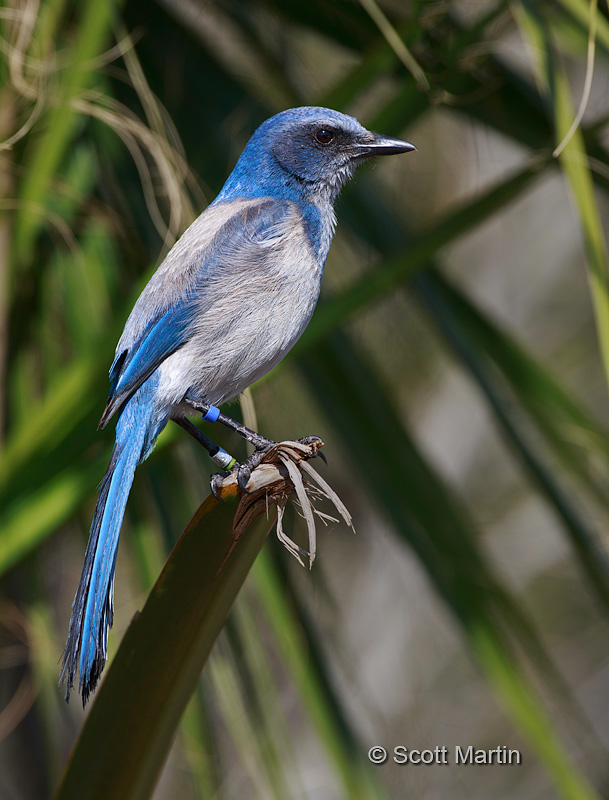
.
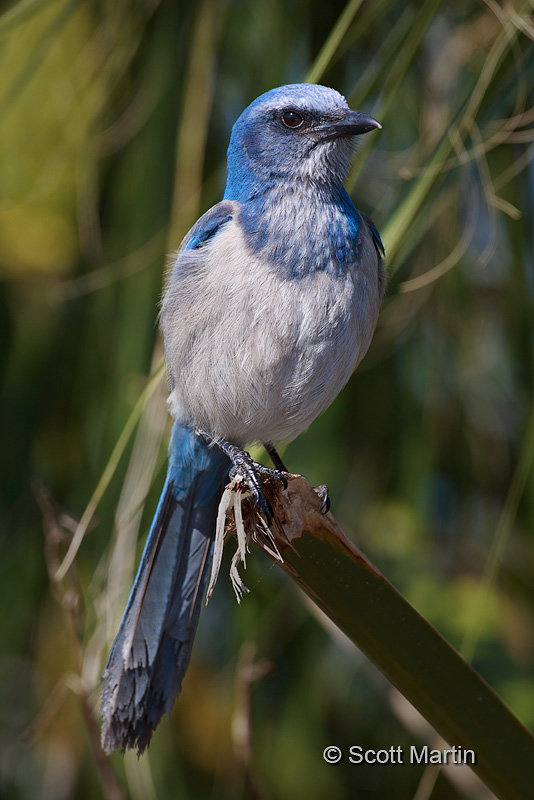
It was hard to get a good shot of the back of Scrub Jay, so please excuse the busy back ground in this next image.
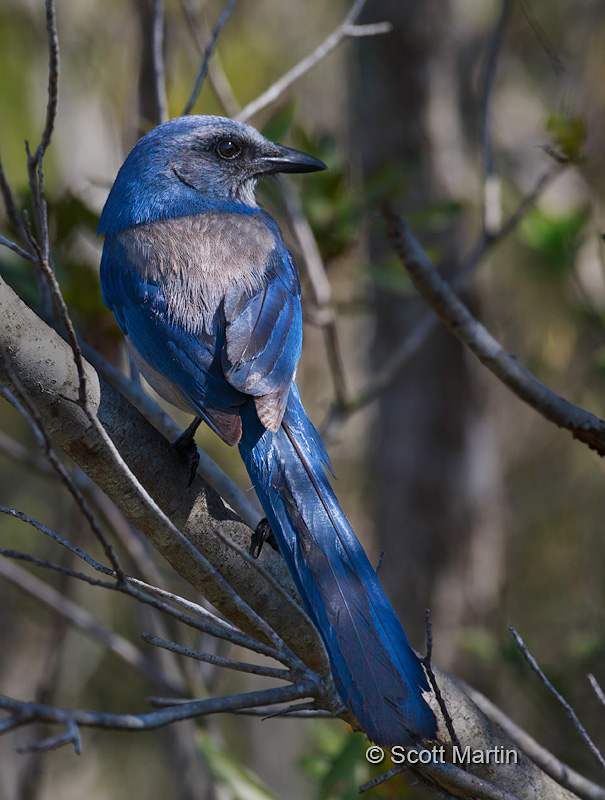
Other Scrub Jays can been viewed in the Jays Ravens & Crows Gallery
From a photographic perspective, getting bird images that are more than just snapshots requires controlling as much of what the final image will look like as possible. For me that involves thinking about the back ground as much as the object, which is not an easy thing to train yourself to do. When was the last time you looked through your viewfinder and thought as much about what was in the back ground as you did the object? If you are like me, you may not have thought about the back ground at all! A few suggestions to help improve your results next time out are; look for the least cluttered back ground as possible, look for uniform light density throughout (avoid bright spots, especially ones that encroach on the object), try to get as much distance between the object and back ground as possible which helps blur the back ground and isolate the object. Don’t forget to move around with your feet or zoom with your lens to help accomplish the above suggestions. In terms of thinking about the object, next to ensuring proper focus, exposure and light direction, for me the most important thing is to avoid shadows on the bird. This is not always possible due to the nature of bird photography however it is always the ideal. Have a another look at the second image in this post and see how distracting the shadow on the tail is…almost ranking up there with the bands! The last image is greatly hampered by the cluttered background (which is exacerbated by the lack of separation between the object and back ground) and that half of the tail is under a shadow, however as is often the case, it was the only frame that clearly showed the back of the bird, no matter how hard I tried to get that ‘keeper’ shot of the back.
So next time, try to think about the things that will help move your results from snapshots to photographs, but never think so much about the results that you don’t enjoy your time out with your camera!
All the above images were taken with a Canon 5D MkIII and 500mm lens using a Jobu monopod and Jobu Jr. 3 gimbal head.
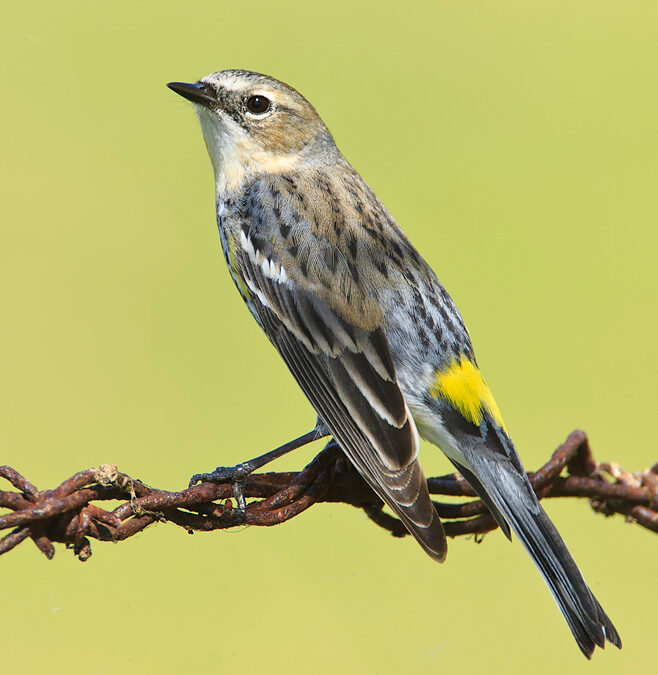
by Scott Martin Photography | Apr 11, 2013 | Birds, Blog, Shore Birds & Waterfowl, Warblers
Although we are expecting a snow storm tomorrow, the early migrants are returning to the area after wintering down south. It’s great to hear their songs every morning as I leave for the office. Probably my favourite birds to photograph in the spring are the many warblers that pass through the Oshawa area in May & June. Oshawa is a unique warbler location as there is a small woods next to the lake that contains the only remaining “Old World” White Pine stand on the North West shore of Lake Ontario and many of the warblers desire this unique habitat. One of the more common warbler species is the Yellow-rumped Warbler and we were fortunate to photograph one while in Florida last month.
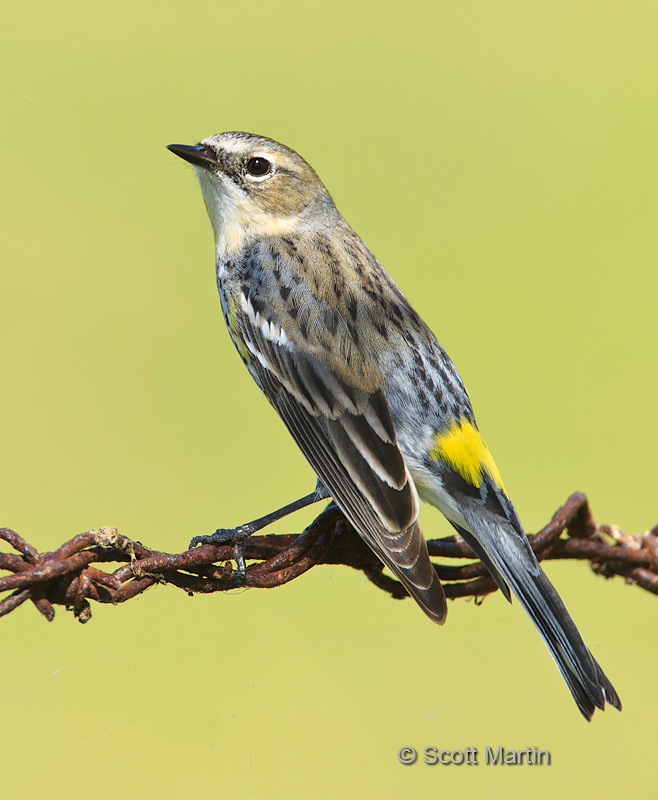
.
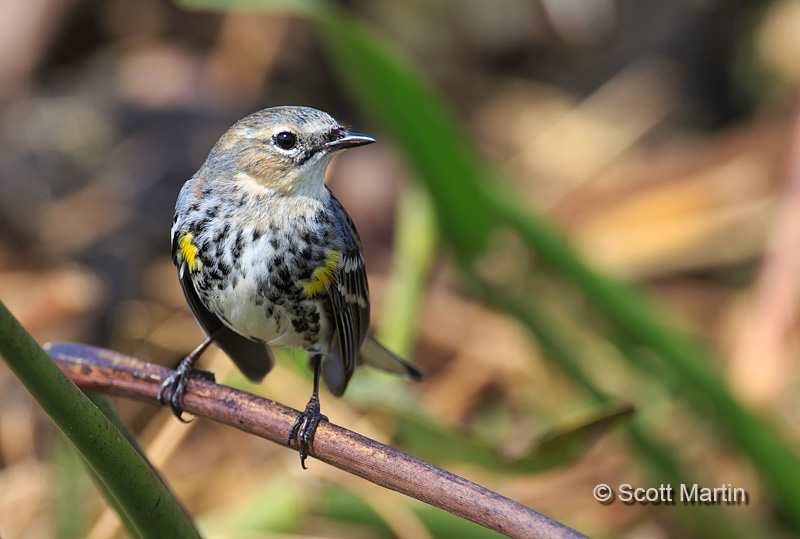
.
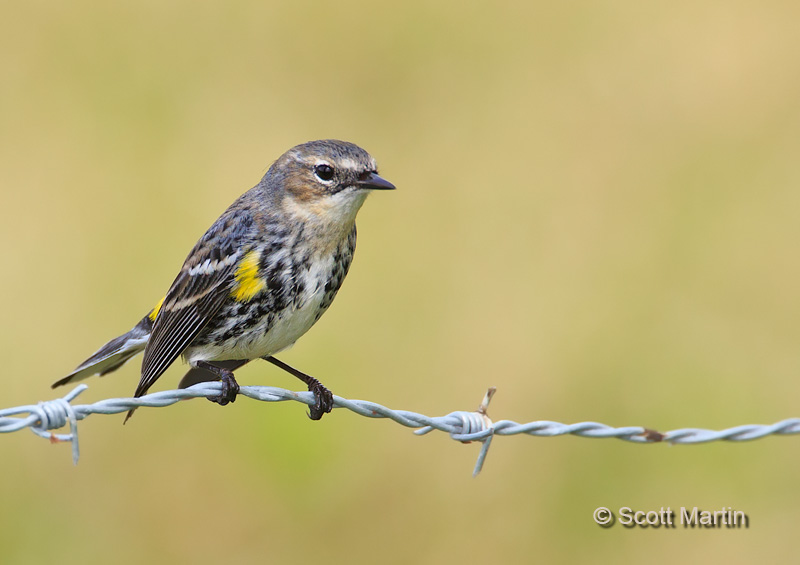
Normally we don’t post images on man-made perches, however a nice pose against a clean back ground makes the barbed wire seem not quite as bad!
This Yellow-rump was photographed at Lake Kissimmee in Florida at the end of Joe Overstreet Road. Other warbler images can be seen by following this link to the Warbler Gallery.
While in Florida visiting the Merritt Island Nature & Wildlife Preserve we were fortunate to photograph a number of Lesser Scaups. Lesser Scaup’s prefer fresh water (Greater Scaups like salt water) and are one of the most abundant diving ducks in north America although in recent years their numbers have been in sharp decline. Even though Scaups are common, this was the first time Deb and I had ever seen or photographed them.
Male in breeding plumage.
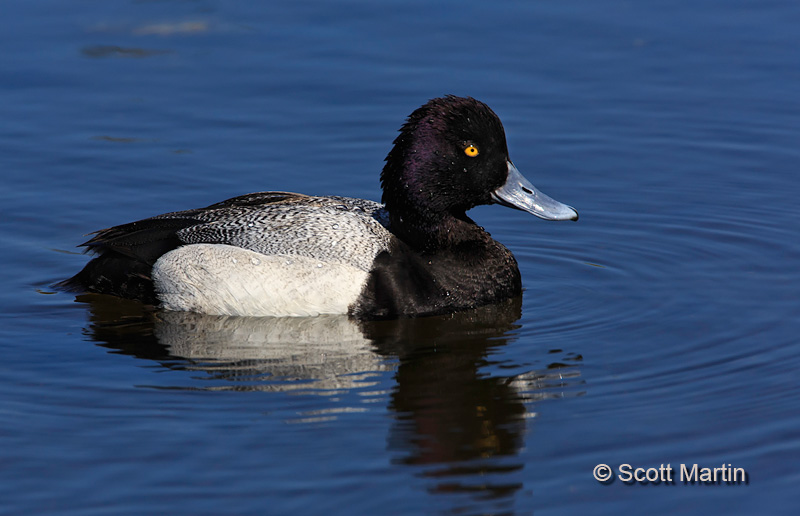
This next image is not as visually appealing as the previous image because the reflection of the head is cut of by the bottom of the frame, however it does clearly show the unique marking on the distal aspect of the bill, which is why it is included in this post. Any elements of visual importance in an image tend to detract from the image when they touch the edge of the frame so try to leave ample room around your subject when out taking pictures. You can always crop the image in post processing, however when you crop the image “in the camera” like I did in this next shot, you are stuck with less than ideal results.
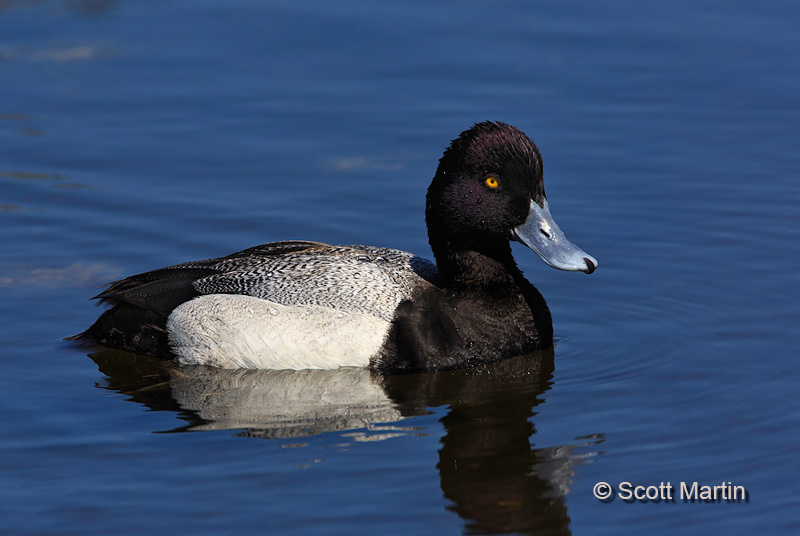
Non breeding male plumage or a young male.
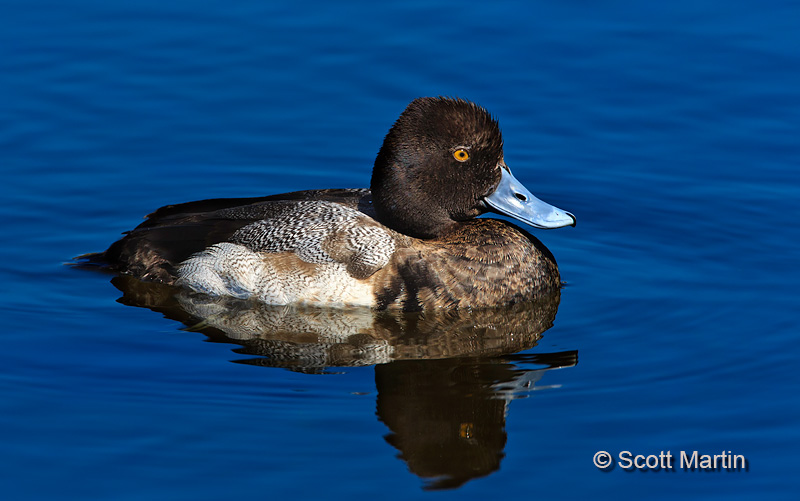
Female Lesser Scaup.
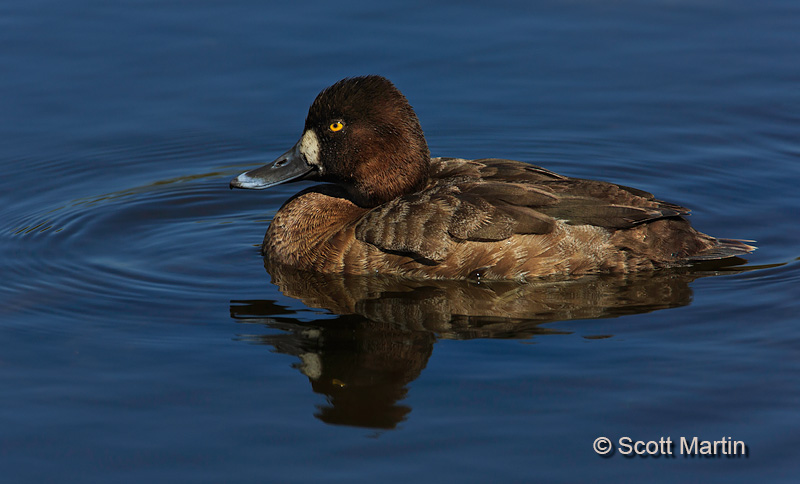
.
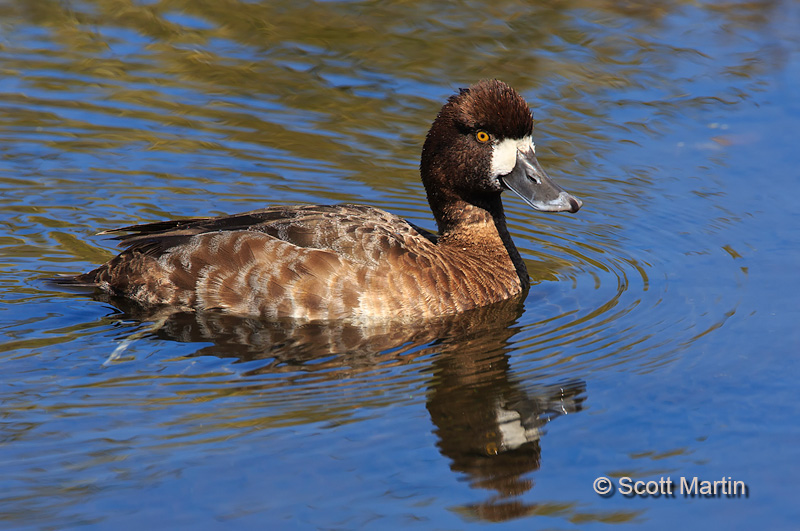
All images in this post were taken with a Canon 5D Mk III and EF 500mm L IS lens supported on a Jobu monopod and Jobu Jr. 3 gimbal head.

by Scott Martin Photography | Mar 29, 2013 | Birds, Blog, Raptors, Shore Birds & Waterfowl
Birders and bird photographers traveling to Florida need to make it a priority to travel the five miles along Joe Overstreet Road; a gravel road that ends at the shores of Lake Kissimmee. The variety and quantity of birds that are experienced never disappoint. Deb and I have been making the trip for a number of years now, and although we often see Eagles from afar, this year a couple of mature Eagles, flying with a group of Black Headed Vultures, made a pass fairly close overhead. It was quite a surprise as I was at the water’s edge photographing a Wilson’s Snipe which had been actively foraging for quite a while when suddenly it dove for cover and hunched down on its belly, a sure sign that it was troubled by something. When a bird acts like this it is a sure sign to look up, which I did, expecting to see a hawk overhead, however this time it was a Bald Eagle about thirty feet above my head.
A rather inauspicious entrance to a fabulous birding experience.

The Wilson’s Snipe that alerted me to the Eagles (note the meal he has just extracted from the mud).
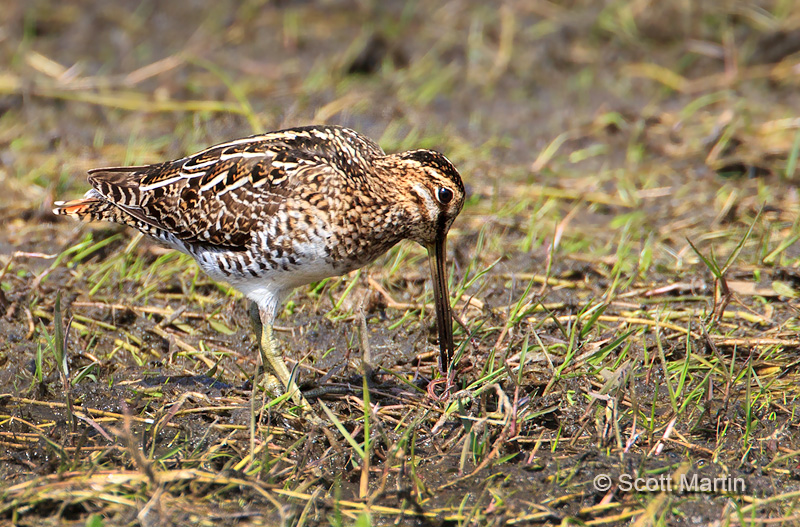
The Bald Eagle is one of the most well known birds in the world, certainly among the Americans who have claimed the Eagle as their National Bird since 1782 and it appears as the central figure in the American Seal. Bald Eagles have a lifespan in the wild of up to forty years and in captivity have lived even longer, although in the late 20th century they were on the brink of extinction due to hunting and the effects of DDT use. In 1963 there were only 417 known pairs and due to concentrated conservation efforts that number increased to 10,000 by 2006. The Bald Eagle is now a common bird in the United States and its name was removed from the list of American Endangered and Threatened Wildlife Species in 2007.
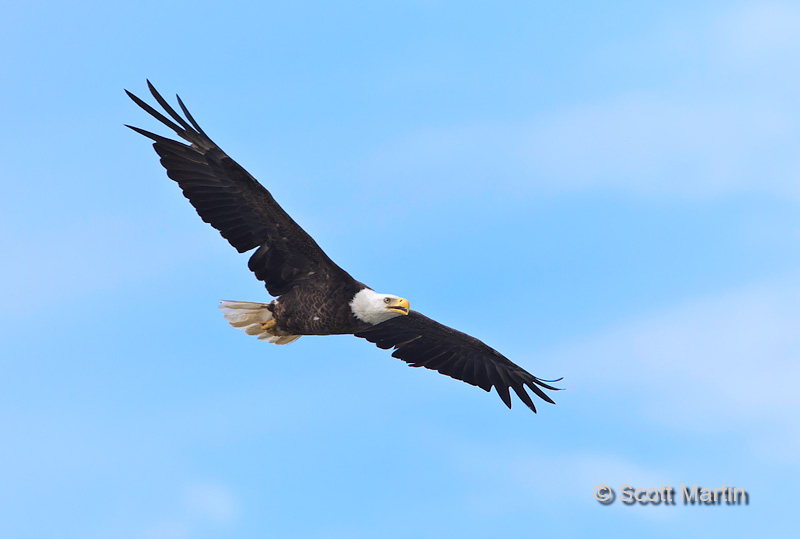
.
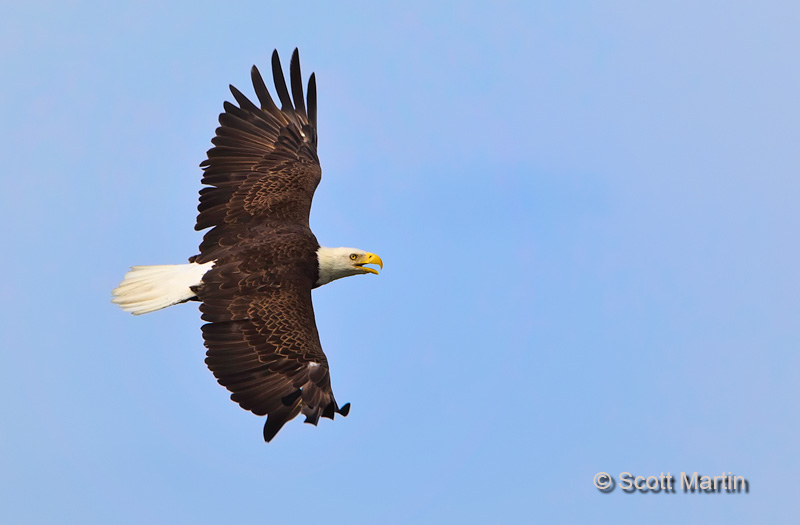
.
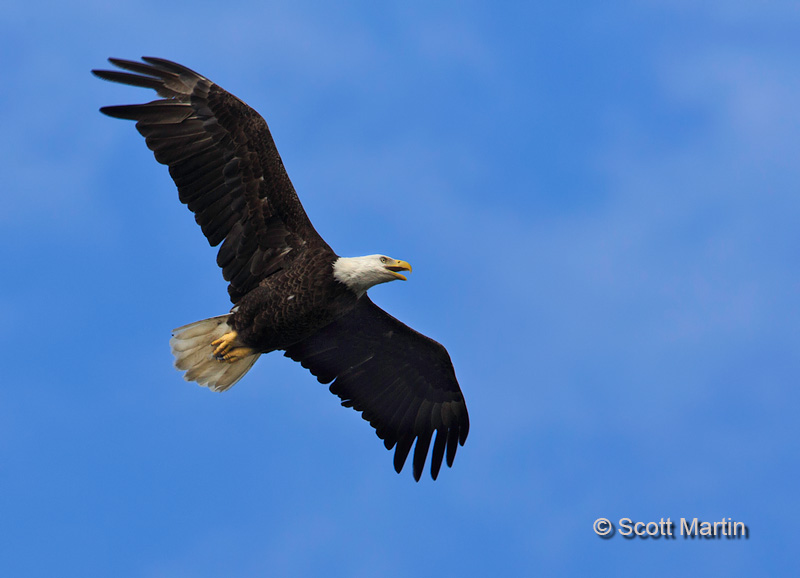
The Eagle images in this post were captured using a Canon 5D MkIII with a 1.4 x TC and 500mm f/4 lens which is not typical gear for inflight bird photography. The camera has a slow frame rate and the use of the teleconverter slows down the auto-focus speed. Both of these issues conspire to reduce the keeper rate so I was pleased to get a few good frames.
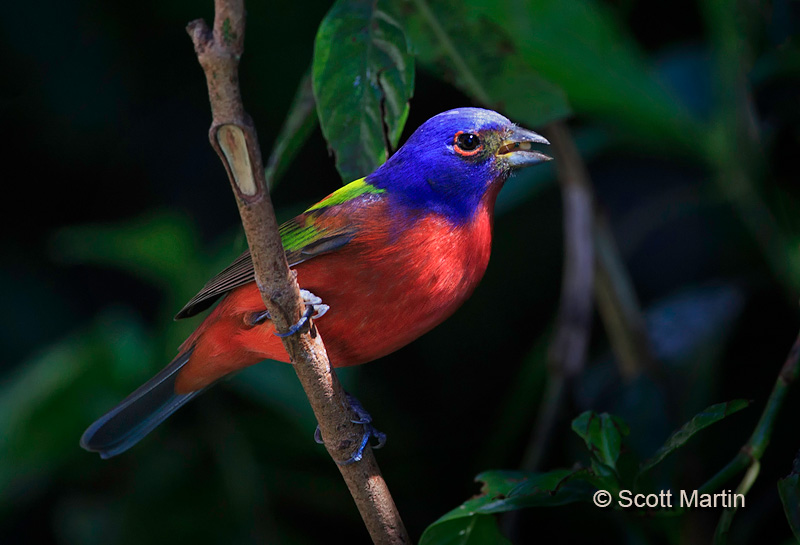
by Scott Martin Photography | Mar 25, 2013 | Birds, Blog, Educational, Song Birds
While in Florida this month Deb & I spent a couple of days visiting Merritt Island National Wildlife Refuge on the Space Coast of Florida. Actually Merritt Island is the Space Coast as the Wildlife Refuge shares the island with NASA. We were fortunate to see and photography a number of different birds on the refuge including Scrub Jays, Northern Shovellers, Greater Scaup, White Pelicans and the subject of today’s post, Painted Buntings, which neither Deb nor I had ever seen before.
Painted Buntings are native to North America and generally noted as our most colourful bird. This makes identification of the male Painted Bunting very easy, even though not many get to see them. The female, although more uniform in her yellow green colour, is also easy to identify as they are the only all green bird found in North America.

These beautiful buntings are from the same family as the Cardinal and the three pairs of Painted Buntings we observed were foraging for seeds with a Northern Cardinal pair. The buntings are a little smaller than the cardinals. Painted Buntings are mostly found in dense thickets and shrubs and are relatively hard to find birds that don’t often provide for nicely perched photographs. You need to be fast, prepared and fortunate to get a good shot.
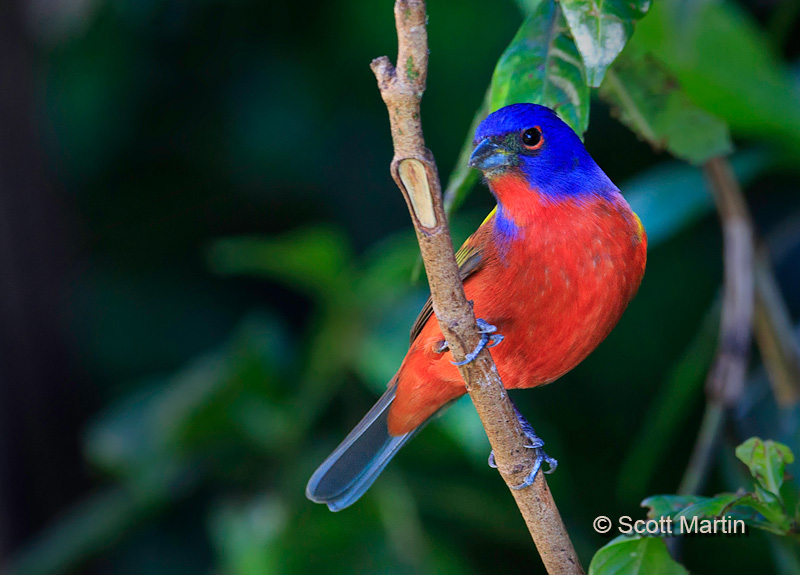
Painted Buntings are found the southern American States and into Central America. Their numbers are on the decline with an estimated 60% reduction in population over the last fifty years. This has been attributed to factors including egg destruction by Brown Headed Cowbirds, urbanization of the riparian habitat they enjoy (transition vegetation between rivers and forests) and climactic change. Although illegal, male Painted Buntings are sometimes trapped, caged and sold as pets which has also reduced their numbers. The Painted Bunting is listed as ‘Near Threatened’.
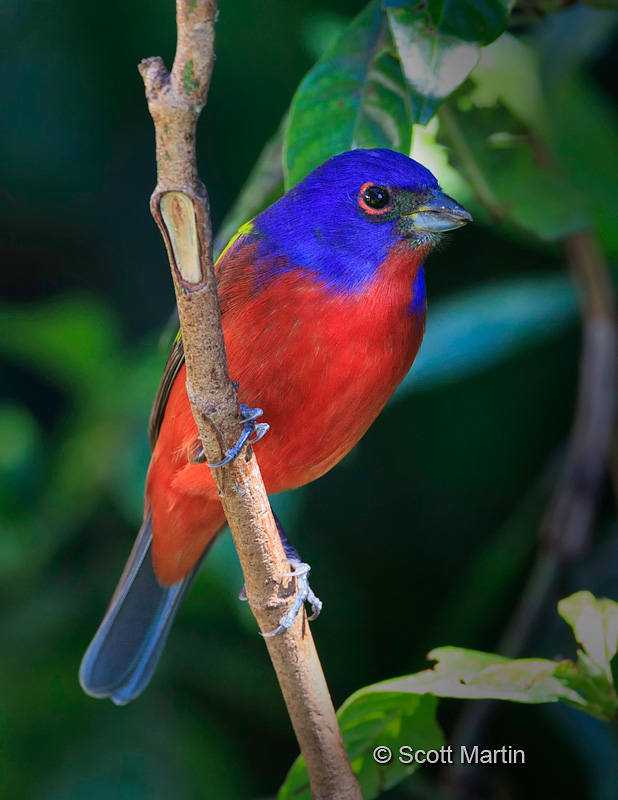
As mentioned earlier the female Painted Bunting is green in colour (a unique distinction for North American Birds) which makes it perfectly camouflaged for its chosen environment. They are easy to hear but difficult to spot as the next couple of images illustrates.
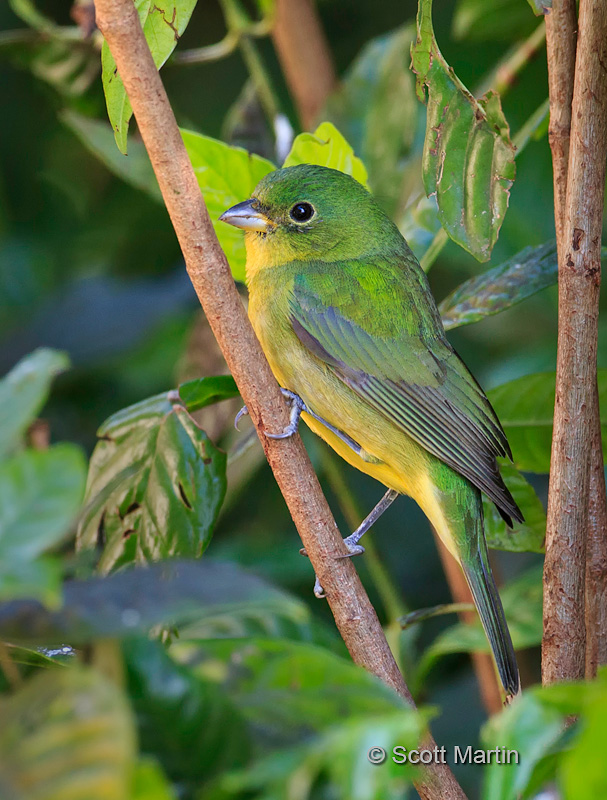
.
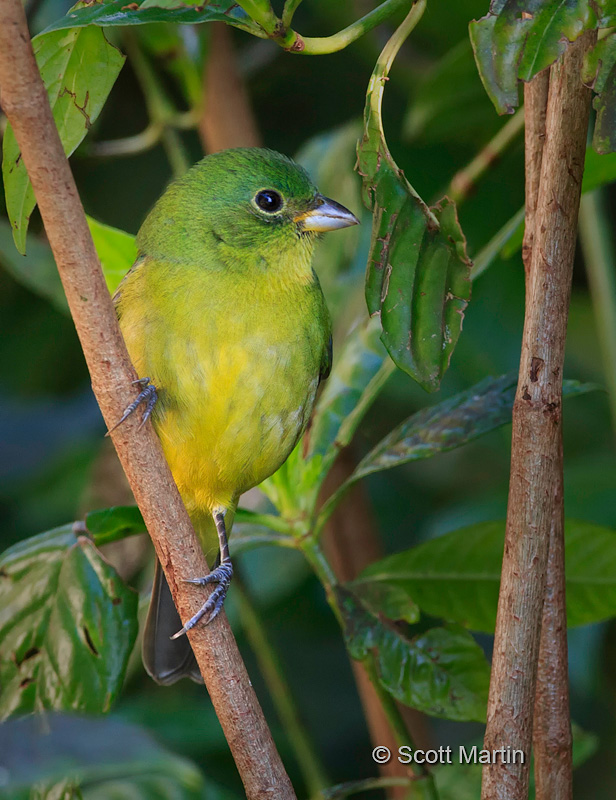
Painted Buntings often forage for seeds along the ground as seen in this last image, which although not a great shot, does show the bird’s many colours and that it truly deserves its reputation as the most colourful bird in North America. Often times bird photographers just get lucky (or have been prepared and given the opportunity enough times) even while ‘breaking’ all the rules of good photographic technique. This shot is one of those times as it was a single frame taken hand held, looking down at the bird using an aperture of f/4 and shutter speed of 1/250 sec with a 500mm lens. I wont take the time now to explain why, but if you are a photographer you will know that this shot could be attempted a hundred times and would be blurry and out of focus ninety nine of those times. There must be some truth to the old adage of it being better to be lucky than good!
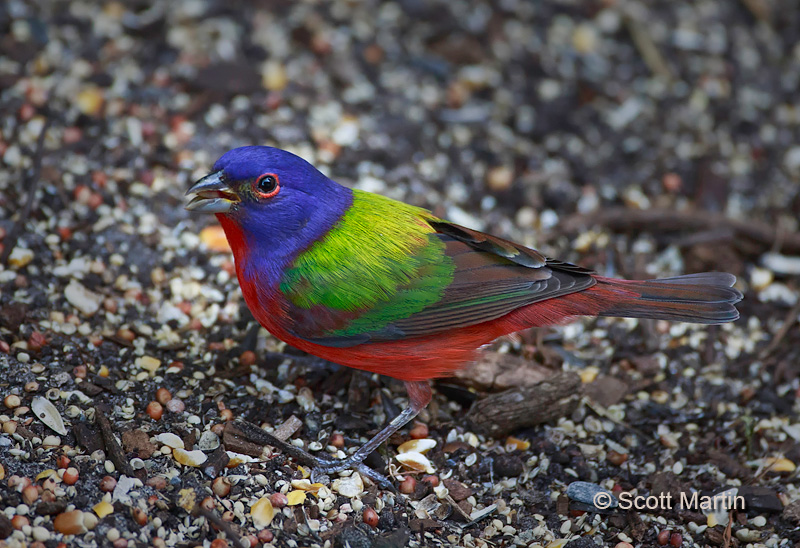
All of the images in this post were taken using a Canon 5D MkIII body and Canon EF 500mm IS L lens.
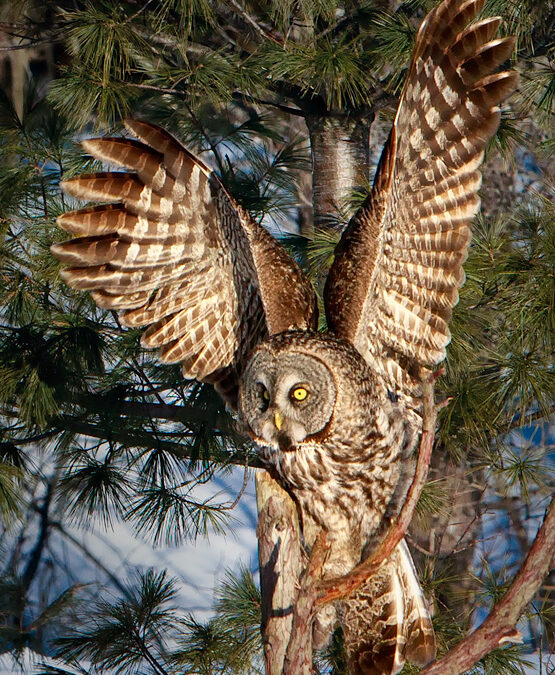
by Scott Martin Photography | Mar 1, 2013 | Birds, Blog, Educational, Raptors, Wildlife
After reviewing the Great Gray Owl shots Deb & I were able to capture in Ottawa a couple of weeks ago, I found a few more that were perhaps nice enough to post.
Although the Great Gray Owl is exceeded in weight by a number of other owls, its large head and long tail help it to be the largest and tallest Owl known in the world. Female adults are almost three feet in length with a wing span of five feet. The average female weighs three pounds although Great Grays have been found as heavy as four pounds.
With their wings outstretched you get a glimpse of just how large these owls are.
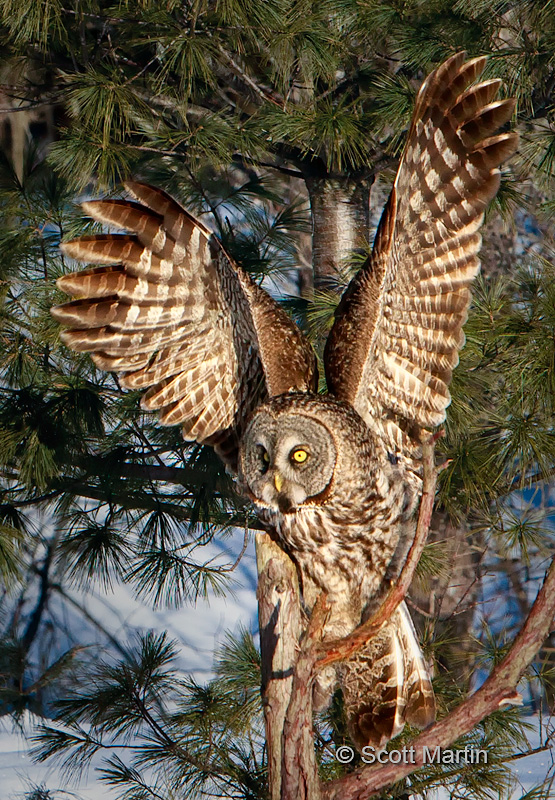
In order to become a better photographer, one has to become their own best, or worst, critic as well as being open to critique from others. It’s the only way we can learn to improve our skills, not only in terms of camera settings and technique but how to think about what a shot is going to look like even before you take it. Although taking pictures of wild birds and animals is difficult and quite spontaneous, you can always make sure you position yourself so the lighting is optimized and many of the elements in the frame (i.e., perch and back ground) are such that they enhance, as oppose to detract from, the resulting image. So lets critique the above image (feel free to leave a comment if you wish); for me technically the face is too soft (a nice way of saying out of focus) and compositionally the perch obstructs and casts a shadow on the owl and the back ground is too close to the bird causing the birds to be ‘lost’ in the back ground. Otherwise, I like the wing position and it’s always a treat to be so close to a Great Gray Owl.
Regarding technique, the soft face was simply because I missed focusing on the eye. The depth of field for this image was about 2m, unfortunately that 2m started just behind the owls face! In order to minimize the compositional challenges in this shot, I reduced the saturation of the back ground about thirty percent using Viveza 2, a NIK Software plug-in for Photoshop as well as using Color Efex Pro 4 to adjust the contrast and colour of the owl. Finally a vignette was added to darken the back ground (using a solid color layer in Photoshop). These were done to try to get some separation between the bird and its background. Another option would have been to blur the back ground, however I chose not to do so as it would have produced an un-natural ‘Photoshopped’ look. Sounds ironic, but virtually all digital images are processed (often heavily) yet the goal is to have a Photoshopped image that doesn’t look Photoshopped!
This next image is included simply for our discussion on critique and as an example of a common occurrence in wildlife photography……what could have been a ‘keeper’ but is ruined by an uncontrolled factor, in this case the owl flew into a deep shadow.
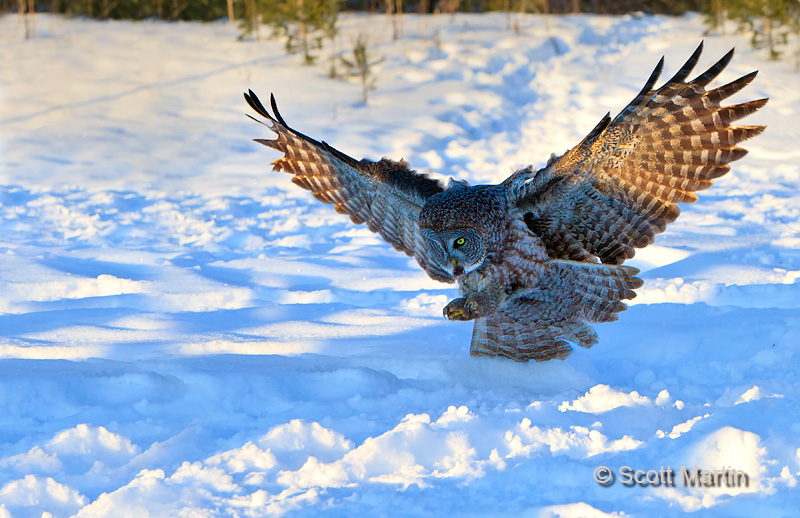
A lot of time was spent in post processing trying to get some detail out of the shadows and add enough contrast, colour and saturation to make the image ‘acceptable’ however it still doesn’t quite work as a great image. In this image the canvas was increased significantly, the back ground cleaned up a dark gradient added to the top half of the frame. We need to learn that its important to take great measures to get the shot right in the camera because no amount of time and skill in post processing can turn an average image into a good one. Photoshop doesn’t rescue anything from the recycle bin, yet we often spend way too much valuable time trying!
This last shot is simply out of the camera with no processing other than cropping and an automated Photoshop action preparing it for posting on the web.
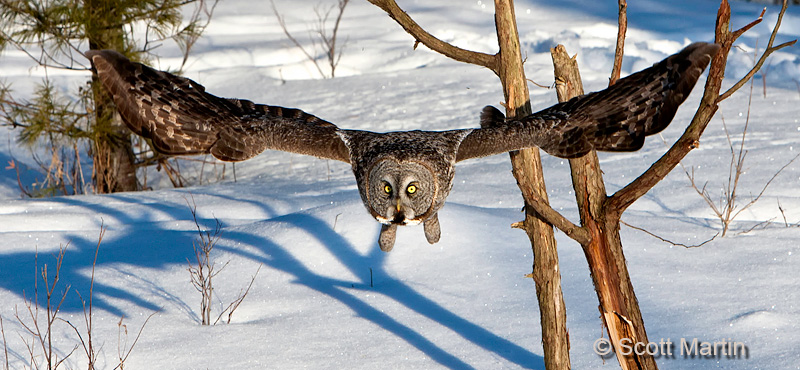
It’s a really busy back ground and won’t end up in a frame anywhere but it does capture the majestic wingspan of a Great Gray Owl and for some reason, purely subjective, I just like it….and that’s the beauty of photography….always strive to get better in every detail, whether it be technical or compositional, but in the end all that really matters is that you simply enjoy the picture!
The three images above were all taken with a Canon 1D Mk III and EF 70-200 f/2.8 L IS lens in -17°C temperatures!












































Follow Scott Martin Photography